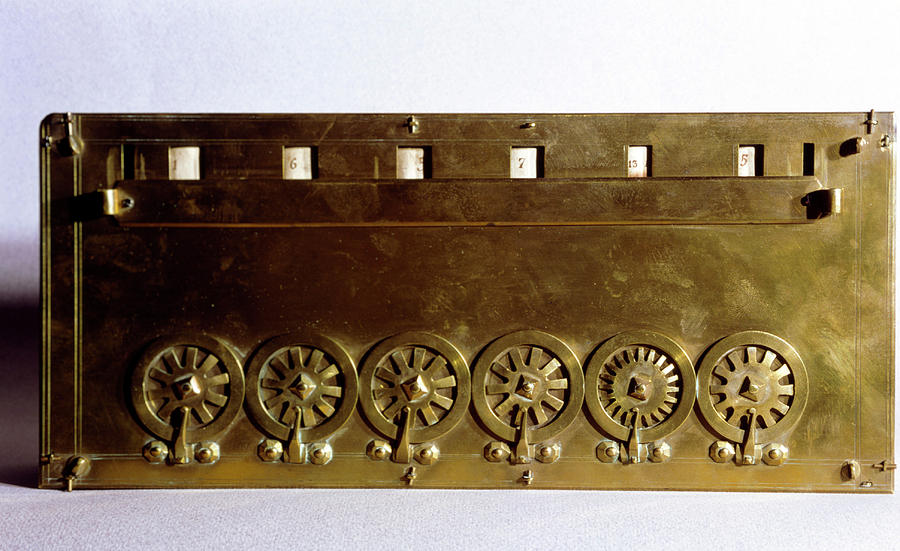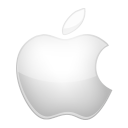
Pascaline
The pascaline, initially called the arithmetic machine then the pascaline wheel, is a mechanical calculator invented by Blaise Pascal and considered to be the first calculating machine. It was in 1642, at the age of nineteen, that he conceived the idea, wanting to relieve the task of his father who had just been appointed superintendent of Upper Normandy by Cardinal Richelieu and who was to restore order to the fiscal receipts of this province; it allowed to add and subtract two numbers in a direct way and to do multiplications and divisions by repetitions.
It was in 1645, after three years of research and fifty prototypes, that Pascal presented his first machine, dedicating it to the Chancellor of France, Pierre Séguier. He built about twenty pascalines in the following decade, often perfecting them; eight of these machines have survived to the present day, a ninth was assembled in the 18th century with leftover parts. A royal privilege, promulgated by Louis XIV, gave him the exclusivity of the production of calculating machines in France.
The pascaline was the only working calculating machine in the 17th century because it used lantern pinions, borrowed from power machines (water mills, bell tower clocks) that Pascal had adapted and miniaturized for his machine. These lantern pinions made it possible to resist the sudden and irregular movements of the operator's hand while adding very little friction to the whole mechanism. In addition, Pascal invented a reporter: the saltire, which isolated each digit because it was thrown from one digit to another only to add a unit of deduction to the next wheel, thus creating a cascading progression of deductions. Thanks to the saltire, the pascaline was not limited in capacity: "for the ease of this... movement... it is also easy to move one thousand and ten thousand wheels at the same time, if they were there... . than to make one move”.
From 1649, Pascal sought to reduce the manufacturing cost of his machine, which made it inaccessible to the general public. In 1654, however, he abandoned the project following a severe head trauma received during a coach accident, and retired definitively from the world of science to devote himself to the study of philosophy and the religion. He is thirty-one years old.
The introduction of the pascaline marked the beginning of the development of mechanical calculation in Europe, then, from the middle of the 19th century, throughout the world. This development, which passed from calculating machines to electric and electronic calculators in the following centuries, culminated with the invention of the microprocessor by Intel in 1971. But it was also Charles Babbage who designed his analytical machine from 1834 to 1837, a calculate programmable which is the ancestor of the computers of the 1940s, this by associating the inventions of Blaise Pascal and Jacquard, ordering, with instructions written on punched cards, one of the descendants of the pascaline, the first machine which supplemented the human intelligence.
The pascaline was the source of many key machines and inventions in this industry. Indeed, it was while seeking to add an automatic multiplication interface to it that Leibniz invented his famous grooved cylinder (1671); Thomas de Colmar was inspired by the work of Pascal and Leibniz when he designed his arithmometer, which, after thirty years of development, would become, in 1851, the first calculating machine marketed in the world; Dorr E. Felt substituted the entry wheels of the pascaline with a keyboard for his comptometer, which would be the first calculating machine using a keyboard and, seventy years later, the first calculating machine to become electronic. The pascaline was also often improved with the machines of Boistissandeau in 1730, but especially with the machines of Didier Roth around 1840, and finally with portable machines until the advent of the first electronic calculators.
Pascal decided to build a calculating machine to help his father whose occupation required a lot of calculations, but which at the time were carried out by (human) calculators with tokens or with a pen. Accounting calculations at that time were complicated by the fact that the monetary system was not decimal since it had 20 sols in a pound and 12 denarii in a sol. It was the same for the calculation of lengths and weights.
He began its development in 1642 and experimented with around fifty prototypes before settling on the design of the first machine which he presented in 1645.




